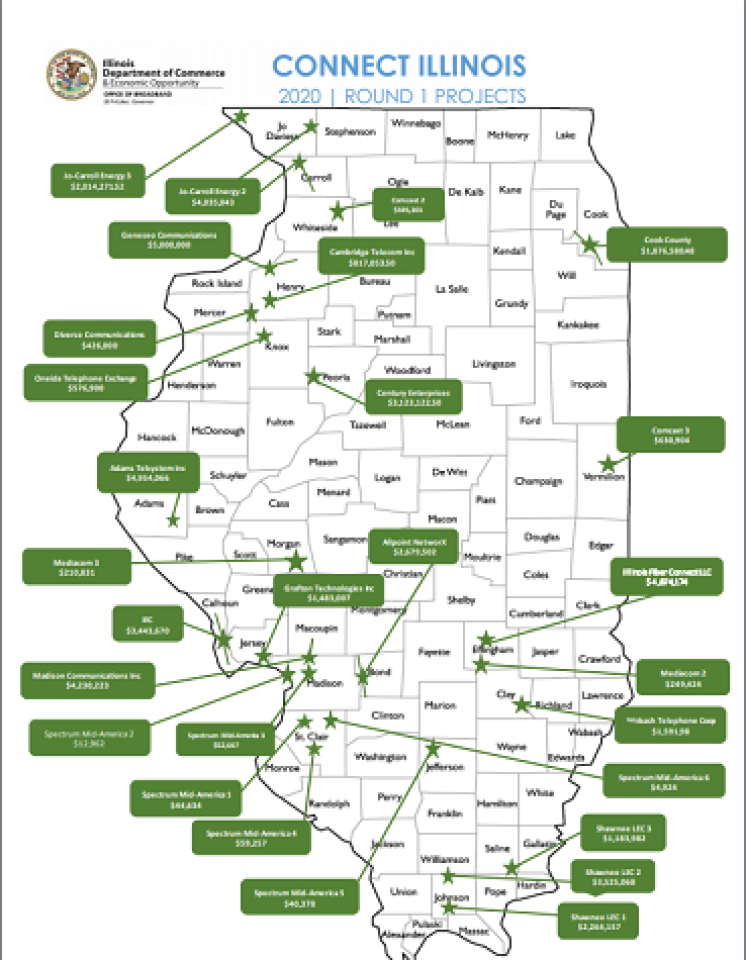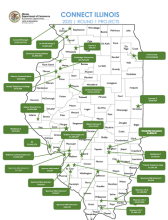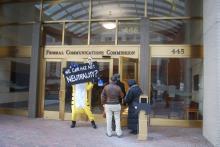
A year ago we wrote about Illinois’ $420 million commitment to broadband expansion, and now the first round of grant winners has been released. Together they total $50 million in state funds matched by $65 million in additional money for 28 projects by 18 different Internet Service Providers (ISPs) that will, ultimately, connect 26,000 homes, farms, community institutions, and businesses in the state. It represents the first milestone in what is a significant commitment to closing Illinois' broadband gap.
Lots of Winners, Some Caveats
The Broadband Grant Program offers applicants up to $5 million in funding for projects with the stipulation that they match it with an equal or greater amount of other, nonstate funds. First-round winners consist of both middle- and last-mile builds touching at least 27 counties throughout the state. For example, Cook County received a little under $2 million to expand its Chicago Southland Fiber Network (CSFN). CSFN provides backhaul services to many, including the Illinois Century Network — which serves over 3,400 public K-12 schools, universities, and libraries. Their application committed to focusing “on fiber paths that will provide distribution and host last mile service platforms addressing those communities with the greatest need, municipalities with no fiber assets . . and key regional education campus facilities.”

In total, providers representing local control and democratic decision-making did well. The Illinois Electric Cooperative got a little under $3.5 million to build out symmetrical 1 Gigabit per second (Gbps) last-mile connections to 746 unserved households and 95 businesses, farms, and community anchor institutions in Calhoun County. Currently, its telecommunications division accounts for a relatively small but growing proportion of the services it provides to its more than 14,000 members across the state. JoCarrol Energy Cooperative, founded in 1939, also received $6 million to complete connections to over 1,500 homes and businesses across Carroll, Jo Daviess, Stephenson, and Whiteside Counties. It currently serves 26,500 members.
“High speed Internet access is just as important to a farmer in Henry County as it is to a corporation in a downtown Chicago high-rise,” said Mike McClain, CEO of Geneseo Communications (which received $5 million to connect 3776 premises to its 1 Gbps symmetrical Fiber-to-the-Home (FTTH) service) of the awards, lauding its effort to put “our communities on a level playing field with the best-served cities across the globe.”
Large, out-of-state ISPs also cashed in. Comcast received a little over a $1 million, Mediacom $459,000, and Spectrum Mid-America, a subsidiary of Charter Spectrum, got $214,000. Spectrum’s application shows its interests lay in connecting households in the suburbs just outside of Saint Louis, where it provides service. See the full list of winners.
One notable contrast between the state’s member-owned endeavors and monopoly cable and telecom providers who received grants are the download and upload speed commitments made. Comcast’s application characterizes its offering of 1 Gbps/35 Mbps to customers as “some of the fastest and most reliable broadband speeds available nationwide.” Likewise, Spectrum boasts that its planned buildout of 940/35 Mbps “exceed[s] the State’s 2028 speed goals of 100/20 Mbps.” Meanwhile, the Illinois Electric Cooperative and JoCarrol Energy will both use grant money to build 1 Gbps symmetrical connections for their customers. Smaller private providers like Allpoint NetworX promises 1 Gbps symmetrical connections “as demand warrants,” with initial commitments of symmetrical plans at 100 Mbps and 125 Mbps, as well as a 500/125 Mbps plan. Another caveat is that Comcast’s Xfinity and Mediacom both come with data caps; it doesn’t really matter how fast your home broadband is if overage charges are prohibitively expensive, especially as the country continues to move more of its output to home networks during the ongoing public health crisis.
The Illinois Broadband Office has helpfully provided a Round 1 Map of grant winners, as well as a map of ongoing proposals that it couldn’t fit into this round of funding.
Connect Illinois

The Connect Illinois Initiative, from which the broadband grant program is borne, started back in June of 2019 with $420 million in planned expansion grants, including $20 million earmarked for upgrades to the 100 Gbps Illinois Century Network, which serves public schools and libraries across the state. Grants are administered by the state broadband office, which also does significant work to identify federal grants to help local communities. Also part of the effort is the Broadband Advisory Council, a policy recommendation group made up of ISPs, state agency officials and legislators, and stakeholders aimed at addressing access, economic development, education, infrastructure and technology, and telehealth as part of the Illinois Broadband Strategic Plan which aims to also ensure that:
- By 2024, all Illinois homes, businesses, and community anchor institutions throughout the state have access to basic service of at least 25/3 Mbps.
- By 2028, Illinois homes, businesses, and community anchor institutions throughout the state have access to at least one provider offering 100/20 Mbps service.
- By 2028, Illinois places in the top three nationally, and top 12 globally, for broadband access.
Governor Pritzker said of the strategic plan:
[P]rivate investment has doubled down on relatively profitable service territories – growing the broadband access gap as a result. Connect Illinois will address this market failure and recalibrate the business case for new deployment, aligning public and private investment to connect communities and individual consumers with fully scalable service.

Connect Illinois has pledged to get rural areas and communities of color connected first, and along with the Benton Institute for Broadband and Society and philanthropic organizations has created Illinois Connected Communities — which aims at building the infrastructure, knowledge, skills, and connections communities around the state need to secure reliable, high-speed Internet for their residents moving into the future. The program gives grants of $15,000, 50 hours of expert consultation services, and access to a best practices curriculum. The first round of these grants, totaling $150,000, was announced on July 9.
Connect Illinois has been busy with other efforts as well, putting together a Drive-Up Wi-Fi Hotspot Map for citizens to use during the coronavirus pandemic, as well collaborating with the Citizens Utility Board to develop a list of mobile and wireline access providers and their pandemic responses (including removing data caps, pledging not to cut off service for lack of bill payment, and any reduced-cost programs it is running).
Pritzker said of the importance of the multifaceted effort:
The unacceptable consequences of disparities in broadband access were clear before the COVID-19 pandemic – and over the last few months, we’ve seen firsthand what it means when a small business that had to close its doors has no online shop, what it means when an elderly couple has no safe way to get medical advice at a distance, what it means when a child has no ability to access homework assignments online. This work has never been more urgent – the disadvantages that persist when our communities are left out of opportunity demand ambitious efforts to bring them to a close.
In other news, the Governor's Emergency Education Relief (GEER) Fund recently announced $108.5 million to be given to preK-12 public schools and postsecondary institutions in response to COVID, but most of the funds look to be going to purchase devices and hotspots. None of the plans currently include additional broadband expansion, and a stopgap solution will only go so far.
Photo by David Wilson via Flickr









